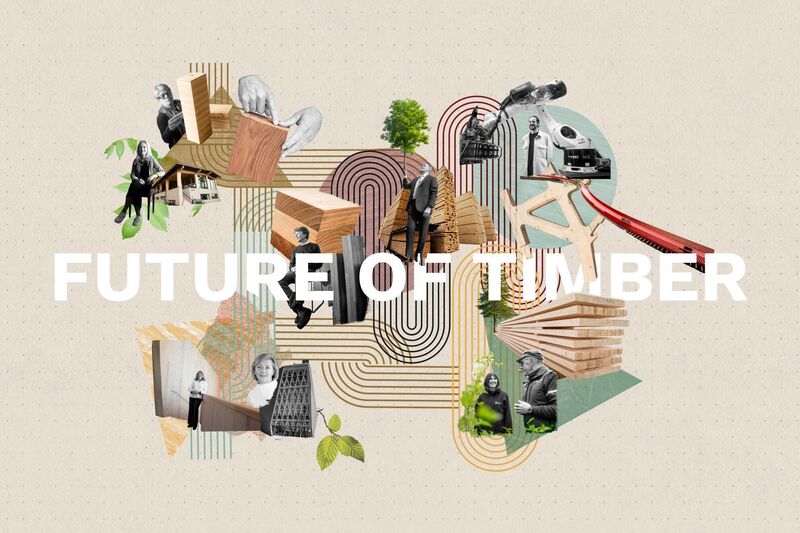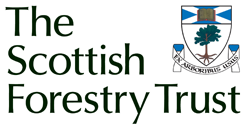Telling the story of timber and trees
Posted on
The Scottish Forestry Trust recently supported an Evolving Forest project entitled The Future Of Timber. The Future Of Timber aimed to challenge stakeholders across the timber value supply chain to better understand each other’s operations, and at the same time, foster richer dialogue and enable more cross-disciplinary collaboration. In this blog post, Katherine Giles, Evolving Forests' Sustainable Timber Specialist, reflects on The Future Of Timber project.
At a time when climate, land use, and construction are deeply entangled, the ways we speak about timber – where it comes from, how it's used, and what it means – have never been more important. With the support of The Scottish Forestry Trust, The Future Of Timber project set out to explore, document, and share stories from across the timber value chain. What emerged is a rich and accessible platform for learning, reflection, and cross-sector connection – with direct benefits for the future of UK forestry.

A platform for shared understanding
The Future Of Timber initiative set out with a seemingly simple aim: to learn from and connect people from all across the timber supply chain in conversations about the changing role of woodlands and timber in a climate-resilient future. With a focus on both the UK and Europe, we produced and curated a collection of case studies, conversations, films, and podcasts that shed light on innovations in woodland management, timber construction, product innovation, and more.
The resulting multimedia platform offers practical insights for forestry, land management and built environment professionals, drawing on real-world examples from across the UK and further afield. Whether it's exploring species adaptation in response to climate change, or examining how localised supply chains are reshaping procurement models, the platform offers UK practitioners a unique opportunity to learn from success – and failure – in comparable contexts.
Thanks to support from The Scottish Forestry Trust, we were able to bring these lessons to life in ways that are accessible and engaging, particularly for foresters, designers, architects, and policy-makers who are not always in dialogue with one another. It is here that the project’s core value emerges: creating new lines of sight between professions that too often operate in isolation.
From forest floor to building frame
The five themes explored on the platform – Species, Radical Realism, Responsibility, Investment, and Bioregionalism – all orbit the central question: how do we balance thriving, biodiverse forests with the increasing demand for timber?
Through storytelling, film, photography and dialogue, we looked at how woodland management and timber utilisation can work hand-in-hand – not only to reduce carbon emissions in construction, but to enhance the health of the forests themselves. We’ve seen, for example, how mixed-species forestry, long-term planning, and transparent supply chains contribute to both ecological and economic resilience.
These narratives are more than theoretical. They offer inspiration and guidance for woodland owners, managers, and timber processors across the UK looking to innovate, diversify, and respond to changing ecological and market pressures.
As one forester reflected after engaging with the platform: “I work in the forestry side of things and it is really great to think about the end product. It alarmed me how little I've ever thought about it past the forest!”
Tangible impacts and sector-wide reach
The response to The Future Of Timber project has been deeply encouraging. The platform recorded more than 1,300 views in its early weeks, with average visitor engagement lasting over eight minutes per session (with a universal average being 53 seconds, depending on your sources). We saw a 315% rise in Instagram interaction and a 222% increase in LinkedIn followers – suggesting a strong appetite for this type of accessible, thoughtful content.
More importantly, the project has initiated real-world conversations. Events and panel discussions connected stakeholders across the UK timber supply chain, creating new collaborations and sparking honest discussion about barriers, responsibilities, and shared goals.
Several participants highlighted how the content prompted them to reconsider long-held assumptions and to seek more collaborative ways of working – especially between forestry and construction. This is where culture shifts begin.
Benefits to forests, ecosystems, and products
Beyond professional networks, The Future Of Timber platform supports broader benefits to woodland ecosystems. By promoting sustainable management practices that align ecological health with timber production, we hope to contribute to better outcomes for biodiversity, soil stability, water retention, and long-term forest resilience.
Furthermore, by championing homegrown materials and advocating for the design and procurement of products derived from UK forests, the platform strengthens the case for a circular, place-based timber economy. It encourages foresters and specifiers alike to see trees not just as commodities, but as part of a larger ecological and cultural system – one that requires care, understanding, and a long-term view.
Looking ahead
Our hope is that The Future Of Timber platform becomes a resource, a catalyst, and a conversation starter. We’ve seen how powerful human-centred storytelling can be when it’s backed by evidence and driven by curiosity. With further support, we’d love to grow the platform’s reach, include multilingual content, and build partnerships that take these insights deeper into education, design practice, and policy-making.
We are deeply grateful to The Scottish Forestry Trust for supporting this project and sharing our belief that telling better stories can lead to better decisions. By combining data with narrative, science with storytelling, and local context with international insight, The Future Of Timber project has created a space where new connections – and new possibilities – can grow.
Explore The Future Of Timber platform, videos, podcasts, and case studies at evolvingforests.com/future-of-timber
